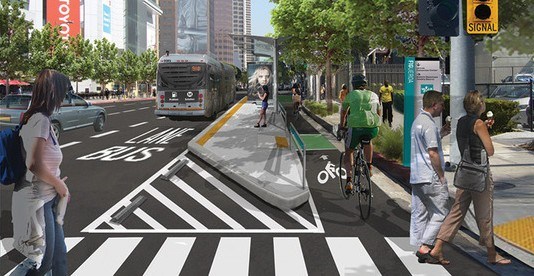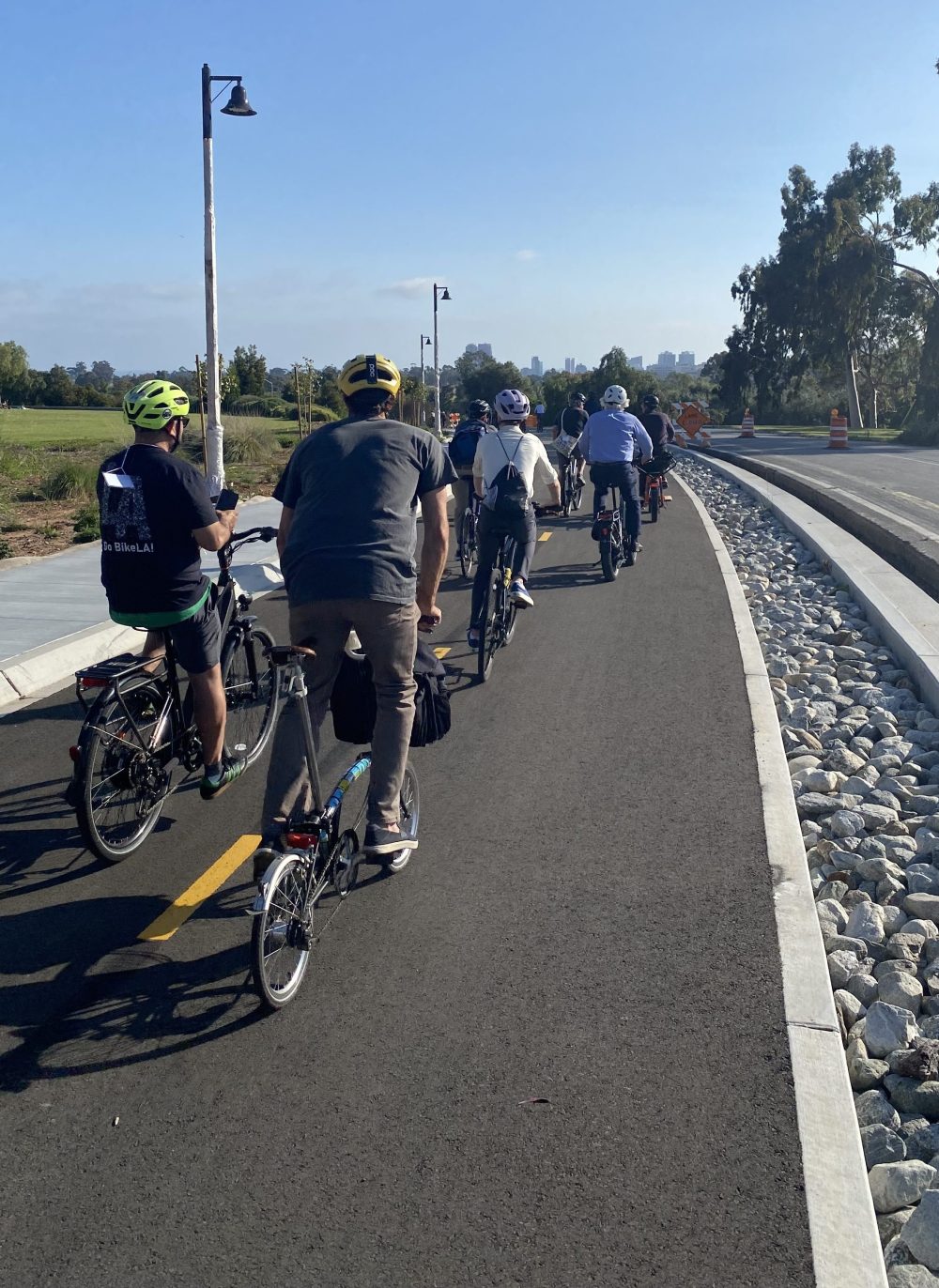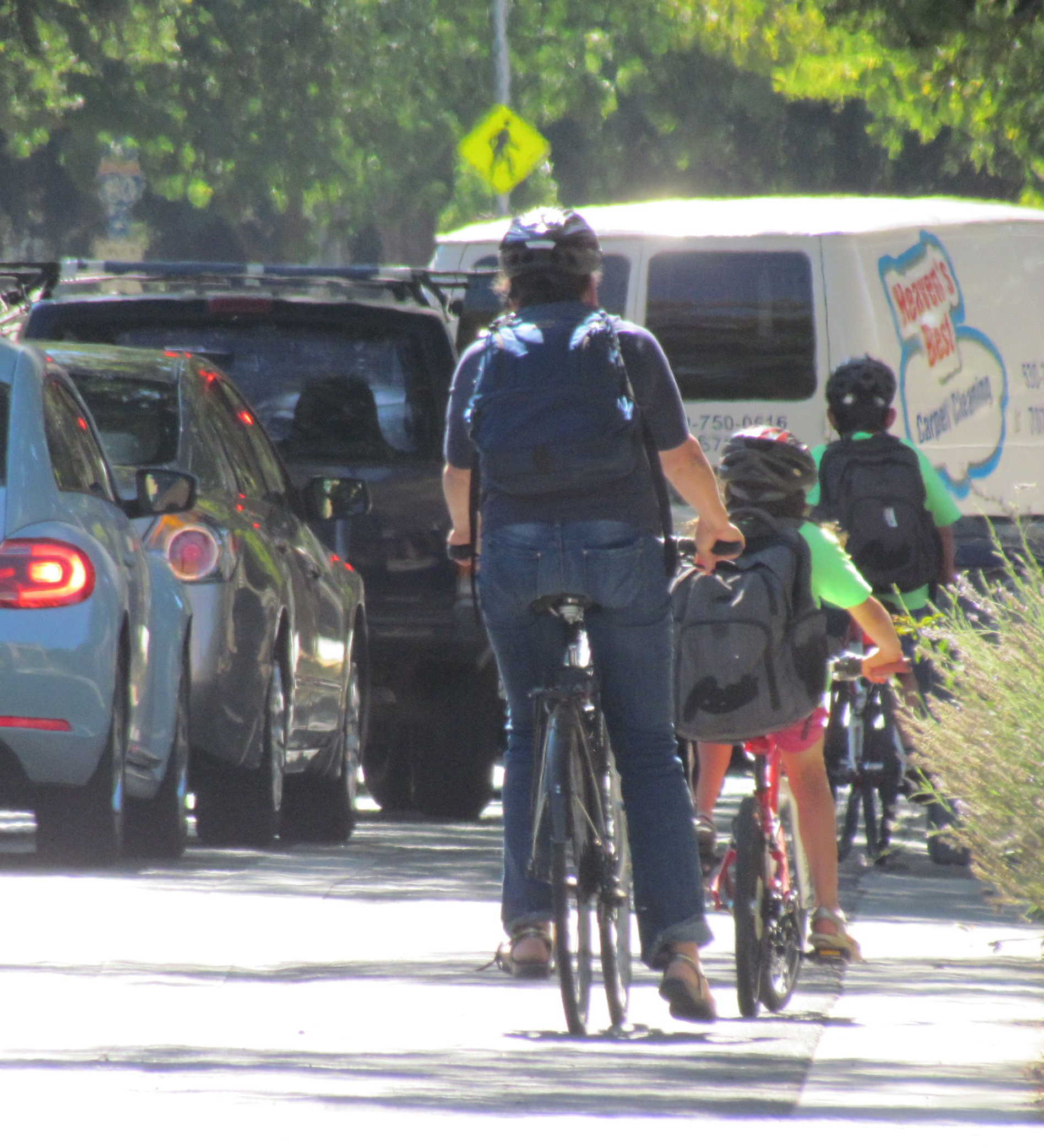What California Could Get from the Federal Bipartisan Infrastructure Bill
1:14 PM PST on December 17, 2021

Note: GJEL Accident Attorneys regularly sponsors coverage on Streetsblog San Francisco and Streetsblog California. Unless noted in the story, GJEL Accident Attorneys is not consulted for the content or editorial direction of the sponsored content.

While the Build Back Better bill may be stalling in Congress, the federal "Bipartisan Infrastructure Law," or BIL, has already been signed into law, and the money will soon be making its way out to the fifty states. This $1.2 trillion act will invest in a wide range of projects including clean water, internet, roads and bridges, and electric vehicle charging stations.
California will be receiving considerably more funding than it has in the past, some of it by formula (based on population and other factors) and some in the form of competitive grants for projects that fulfill specific requirements.
For example, federal highway funding formulas should send about $29.5 billion (over five years) to California for highways and bridges. California already counts on a lot of federal funds for its highway program, but this is more than forty percent over what it has been receiving. Presumably this will be used for existing programs including the State Highway Operation and Protection Program and the State Transportation Improvement Program.
While programs paid for by California's gas taxes are supposed to focus on maintenance needs - the "fix-it first" requirements of S.B. 1 - these federal funds don't include that restriction (although the FHA is gently requesting states to invest these large amount of money wisely).
There is about $110 billion available for highways and bridges nationally, which pretty much dwarfs all the other bits of funding. However, there is money for safe and sustainable transportation investments in the BIL. Some will come from competitive grant programs, both new and expanded ones, and some will be distribute by existing formula to states based on population and other requirements.
Details on the new programs are still being worked out, but below is a quick rundown of what's known so far.
Safe Street for All
Details about this $6 billion program are scarce, although there are lots of suggestions from advocates.
This is a new competitive grant program for local and tribal governments to "support efforts to advance vision zero plans and other improvements to reduce crashes and fatalities, especially for cyclists and pedestrians." Given that California has years of experience developing its Active Transportation Program, and has clearly demonstrated that the state can't meet the demand unless it raises the program's funding levels, the state is likely to be a strong competitor for money in this program.
The California Transportation Commission has already floated a request to the state legislature for an extra $2 billion as a one-time boost for the ATP, and has been formulating plans for how to deploy it (first would probably be to award grants to projects that competed well in the most recent application cycle but didn't win funding; another idea has been to develop regional "bicycle highways" to enable safe bicycle commutes over longer distances). At any rate, California is in a good position to be able to deploy grants for this kind of safety improvements pretty quickly.
Highway Safety Traffic Programs
California is set to receive $179 million (over 5 years) in "Section 402 formula funding for highway safety traffic programs, which help states to improve driver behavior and reduce deaths and injuries from motor vehicle-related crashes." This is about a 29 percent increase from previous allocations.
California's Section 402 formula funding goes through the Office of Traffic Safety, which gives out grants to police departments, community organizations, and local jurisdictions for various programs aimed at improving safety. These include community safety assessments, bicycle education programs, and advertising campaigns - which usually put out a message of "shared responsibility" that places equal responsibility for safety on people walking, riding bikes, and driving two-ton weapons.

OTS also relies on an assumed correlation between police enforcement and increased safety, calling this a "data-driven" approach. But at least one of its grant programs, for "bicycle and pedestrian safety," goes out to police departments statewide with few requirements other than to report how many tickets the police issued under the grant. Police departments usually issue boilerplate press releases when they are about to launch those enforcement programs, and many focus on making sure they issue an equal number of tickets to bike riders, car drivers, and pedestrians.
This has led to "unintended" outcomes like cops staking out bike boulevards in the city of Berkeley to give tickets to careful bike riders who don't come to a full and complete stop - thus discouraging biking without making any discernible change in safety.
What if OTS could use some of this new money to take a closer look at which programs actually improve safety - and whether their current police department grants make any difference?
Despite this emphasis on enforcement, however, note that federal rules prohibit these Section 402 funds from being spent "on the implementation of automated enforcement programs," which have been proven to increase safety and, if done right, can delete the possibility of biased policing.
The NHTSA has already announced the release of $133 million for Section 402 formula funds, with another $123 million for the National Priority Incentive Programs. These include money for: impaired driving countermeasures, state traffic safety information systems and crash databases, seat belt education and enforcement, prevention of distracted driving, motorcyclist safety - and $6.6 million for pedestrian and bicyclist safety programs.
Public Transit
Based on formula funding alone, California can expect to receive about $10.3 billion over five years to improve public transportation options across the state. That's about 37 percent more than current funding levels, and much needed, as transit has hit a wall during the pandemic - several walls, and kept going, because it's a lifeline for many people.
Formula funding means it will probably be allocated along the usual lines, based on agency revenue and population.
Rail will also receive several pockets of funding, with $22 billion available for Amtrak to work on its maintenance backlog, and $12 billion for "partnership grants for intercity rail service," which would include high-speed rail. There are also competitive rail grants California could compete for, including $5 billion for rail improvement and safety and $3 billion for grade crossing safety improvements.
Other competitive transit grants include an expansion of the existing Capital Investment Grants Program for new high-capacity transit projects. Several projects in California could qualify to compete for the $23 billion available, including Los Angeles' Westside Subway, the San Diego Mid Coast Corridor light rail project, the San Carlos Peninsula Corridor Electrification Project ,and the San Francisco BART Transbay Corridor Core Capacity projects.
Equity and Sustainability
Several new and expanded competitive grant programs are included in BIL.
One is $15 billion for the Rebuilding American Infrastructure with Sustainability and Equity (RAISE) Grants. Four grants for California projects were just announced, for a bike and pedestrian trail network in Yolo County, pedestrian safety upgrades and bus-only lanes in Oakland, bridge retrofits on Yerba Buena Island in San Francisco Bay, and a grade separation project in Wasco in preparation for high-speed rail there.
Other new competitive grant programs include:
- MEGA Projects, which has $15 billion available for "multi-modal, multi-jurisdictional projects of national or regional significance."
- Strengthening Mobility and Revolutionizing Transportation (SMART), which will grant $1 billion "to states, local governments, and tribes for projects that improve transportation safety and efficiency."
- Rural Surface Transportation Grant Program, with $2 billion to "improve and expand surface transportation infrastructure in rural areas."
There is also $1 billion for a pilot program called Reconnecting Communities. This one is aimed at the removal, retrofit, or mitigation of physical infrastructure barriers in communities - including freeways, railroad crossings, viaducts, and "other principal arterial facilities acting as a barrier." The program will provide grants for planning, design, demolition, and reconstruction of street grids, parks, or other infrastructure.
Highways
Of course, there is that highway money in the bill, about eighty percent of the total. Gentle admonishments to "fix-it first" could help support California's efforts in that direction - although there's always the possibility that, while California focuses its funding towards maintenance of the infrastructure it already has, local jurisdictions may have access to more strings-free federal funds.
New leadership at the USDOT and NHTSA understands how important it is to shift investment towards sustainability and safety for all road users, and California state leadership, at both Caltrans and CalSTA, has been advocating a shift in priorities towards climate-friendly investments. But deep pockets of resistance exist at other state agencies.
And California's appetite for highway expansion, even at the expense of homes and safe biking and walking, doesn't seem to be diminishing.
Streetsblog California editor Melanie Curry has been thinking about transportation, and how to improve conditions for bicyclists, ever since commuting to school by bike long before bike lanes were a thing. She was Managing Editor at the East Bay Express, editor of Access Magazine for the University of California Transportation Center, and earned her Masters in City Planning from UC Berkeley.
Stay in touch
Sign up for our free newsletter
More from Streetsblog California
Friday’s Headlines
Inspiration from the Bike Summit; OakDOT proposes standards for temporary safety upgrades; San Diego transforms a fast road in Balboa Park; Stockton transit funding is under threat; More
Active Transportation Program Calls for Volunteer Evaluators
Apply to be a volunteer ATP application evaluator by May 10.
Study: When Speed Limits Rise on Interstates, So Do Crash Hot Spots on Nearby Roads
Rising interstate speeds don't just make roads deadlier for people who drive on them — and local decision makers need to be prepared.
Eyes on the Street: New Lincoln Park Avenue Bike Lanes
The recently installed 1.25-mile long bikeway spans Lincoln Park Avenue, Flora Avenue, and Sierra Street - it's arguably the first new bike facility of the Measure HLA era
Independent Safety Advocates Beef up the Wiggle
Signs and soft-hit posts installed by advocates make the Wiggle bike route calmer and safer for cyclists and pedestrians




